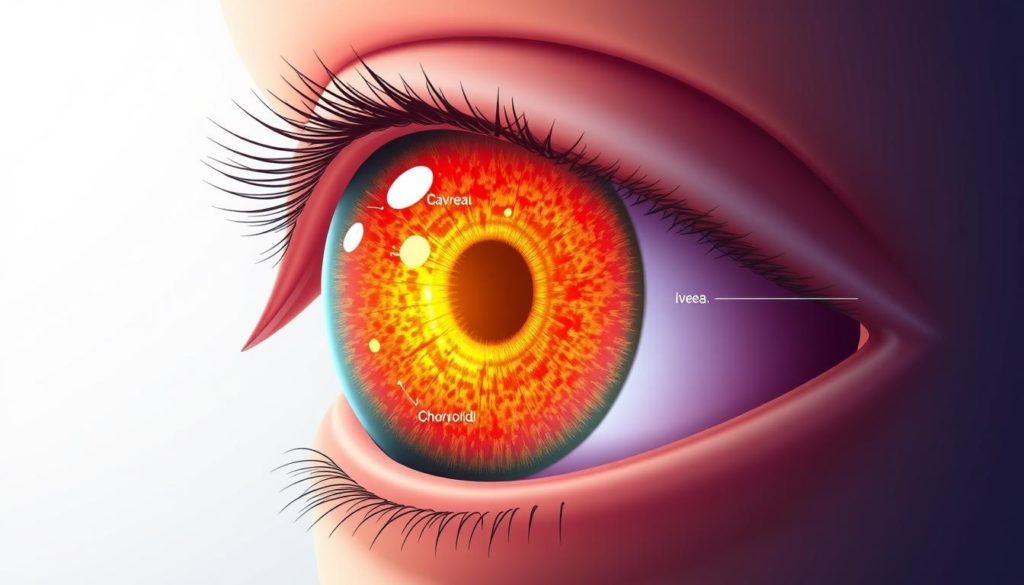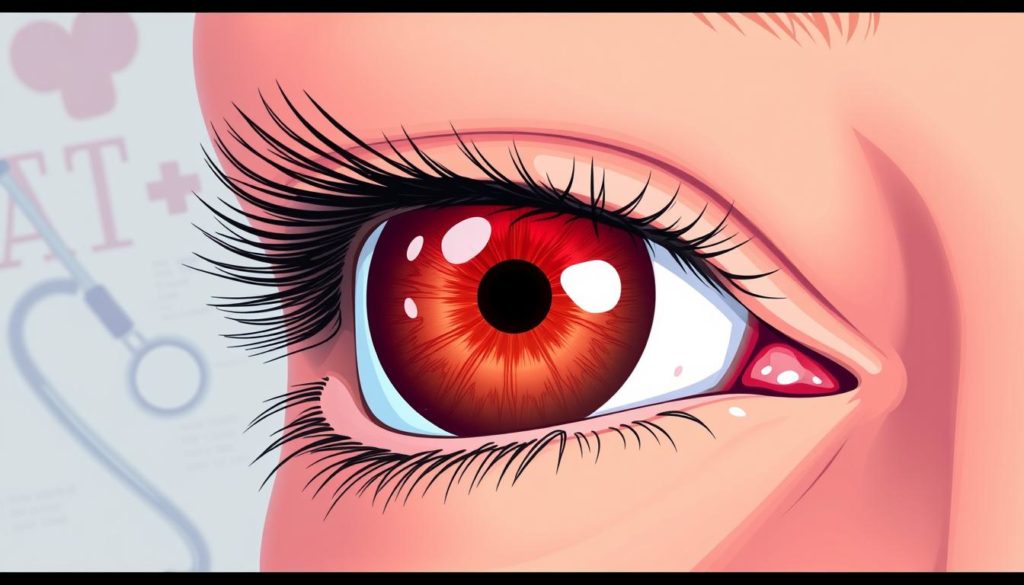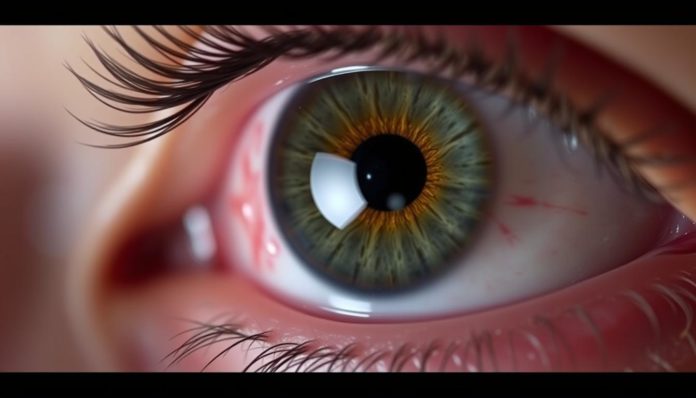“The greatest weapon against stress is our ability to choose one thought over another.” – William James
Diagnosing Uveitis is all about making the right choice. It starts with spotting symptoms early. Symptoms like blurred vision and eye pain are key signs. Knowing these signs is vital for quick action.
This guide will help you understand Uveitis better. We’ll cover everything from the first signs to seeing a specialist. Uveitis is not just an eye problem; it affects people of all ages.
We’ll dive into what Uveitis is, its symptoms, and how it’s diagnosed. By the end, you’ll know the causes, how it’s tested, and treatment options. This knowledge will improve your life quality.
What is Uveitis?
Uveitis is an inflammatory condition that affects the uvea, the middle layer of the eye. It can cause severe eye pain, vision problems, and sometimes permanent vision loss if not treated properly.

Definition and Overview
What is Uveitis? It’s an inflammation of the uvea, which includes the iris, ciliary body, and choroid. This can lead to redness, pain, light sensitivity, and blurred vision. Uveitis can be either acute or chronic, with symptoms varying from mild to severe.
Types of Uveitis
There are several types of Uveitis, based on the part of the eye affected:
- Anterior Uveitis: The most common form, affecting the front of the eye.
- Intermediate Uveitis: Involves the vitreous humor (the jelly-like substance) of the eye.
- Posterior Uveitis: Affects the back portion of the eye and can impact the retina and choroid.
- Panuveitis: Involves inflammation of all parts of the uvea, the entire eye is affected.
Prevalence and Demographics
Understanding Uveitis prevalence and demographics is key to identifying at-risk populations. This condition affects people of various ages, but it’s more common among adults aged 20 to 50. It can also occur in children, albeit less frequently. There are no significant differences in Uveitis prevalence based on race or gender.
According to the American Uveitis Society, about 38,000 people are diagnosed with Uveitis annually in the United States. This number shows the critical need for awareness and early diagnosis to reduce complications associated with this condition.
Common Signs and Symptoms of Uveitis
Spotting the signs of uveitis early is key. It helps avoid serious problems and improves treatment results.
Early Symptoms to Watch For
It’s important to catch early uveitis symptoms quickly. Look out for these first signs:
- Eye redness
- Eye pain
- Blurred vision
- Light sensitivity
- Small, floating spots in your vision (floaters)
Advanced Symptoms and Complications
Uveitis can get worse if not treated. Here are some serious symptoms:
- Severe vision loss
- Glaucoma
- Cataracts
- Retinal detachment
- Optic nerve damage
Knowing both early uveitis symptoms and advanced uveitis signs and symptoms is crucial. It helps people get the right care early, avoiding more health problems.

Diagnosing Uveitis
The process of diagnosing uveitis starts with a detailed check-up and a look at the patient’s history. Doctors use these steps to find out what’s causing the uveitis and if it’s really there. They look at how the eye reacts to light, check for redness, and examine the pupil.
Doctors follow certain uveitis diagnosis criteria during the evaluation. These include:
- Reviewing the patient’s medical and ocular history
- Performing a slit-lamp examination to scrutinize the anterior and posterior segments of the eye
- Measuring intraocular pressure
- Evaluating the patient’s response to topical and systemic treatments
But it’s not just about the physical exam. Doctors might also run lab tests to find out if there’s an infection or an autoimmune issue. Blood tests, imaging studies like fluorescein angiography, and optical coherence tomography are often used.
Here’s a closer look at what’s involved in diagnosing uveitis:
| Diagnostic Measure | Details |
|---|---|
| Patient History | Identify past medical issues, medications, and family health history. |
| Slit-lamp Examination | Thoroughly inspect the eye, detect inflammation signs, and assess anatomical structures. |
| Intraocular Pressure Measurement | Determine any pressure inconsistencies which might indicate uveitis. |
| Laboratory Tests | Check for infections, immune response, and underlying systemic diseases. |
| Imaging Techniques | Use OCT, fluorescein angiography, and other imaging methods to gain detailed eye imagery. |
By using all these methods, doctors make sure they’ve checked everything. Following the uveitis diagnosis criteria helps them quickly and accurately diagnose the condition. This leads to the right treatment and care for the patient.
Understanding the Causes of Uveitis
Knowing the Uveitis causes is key to treating it well. These causes fall into three main groups: infectious, non-infectious, and autoimmune. Each group plays a big role in causing Uveitis.
Infectious Causes
Infectious Uveitis comes from germs like bacteria, viruses, fungi, and parasites. Common causes include herpes simplex virus, cytomegalovirus, and syphilis. These infections cause inflammation in the uveal tract and need quick treatment to avoid serious problems.
Non-infectious Causes
Non-infectious Uveitis can happen from physical injury, toxins, or recent eye surgeries. These causes don’t involve germs but can still cause a lot of inflammation. They need careful diagnosis and treatment.
Autoimmune Factors
Autoimmune Uveitis happens when the body attacks its own eye tissues. It’s often linked to diseases like rheumatoid arthritis, lupus, or ankylosing spondylitis. These diseases cause long-lasting inflammation. They need special treatment to manage both the eye and the disease.
The Importance of Early Diagnosis
Spotting Uveitis early is key to avoiding serious problems and improving treatment results. Catching it early can greatly lower the chance of losing vision and other health issues. Early detection means quick action, which can stop the disease and keep the eyes healthy.
Early Uveitis diagnosis lets doctors create a treatment plan just for you. This might include medicines, changes in lifestyle, and regular check-ups. Together, these steps can make treatment more effective and make patients happier.
Studies show that finding Uveitis early can really cut down on vision loss. Also, people diagnosed early often have milder symptoms and respond better to treatment. This leads to better long-term results.
The social and economic gains of early Uveitis diagnosis are huge. Patients save money on expensive treatments and avoid serious complications. They also get to keep living their lives as usual, with little to no interruption.
| Benefits | Early Detection of Uveitis |
|---|---|
| Immediate Intervention | Yes |
| Reduced Vision Loss | Significantly Lower |
| Improved Treatment Outcomes | Higher Success Rates |
| Cost Effective | Economically Beneficial |
In conclusion, the advantages of catching Uveitis early are clear. Regular eye exams and knowing the early signs are crucial. By focusing on early detection, patients can protect their vision and keep their eyes healthy.
Diagnostic Tests for Uveitis
Figuring out if you have Uveitis involves several detailed tests. These tests help doctors understand what’s going on. This way, they can create the best treatment plans for you.
Ophthalmic Examination
Eye exams are key in checking your eye’s health. During these exams, doctors use a slit lamp to look closely at your eye. They check for signs of Uveitis and other issues. They might also check your eye pressure with tonometry.
Blood Tests
Blood tests are vital for finding out what’s causing Uveitis. They look for signs of diseases that might be linked to Uveitis. Tests like ESR and CRP help spot inflammation.
Imaging Techniques
Imaging tests use advanced tech to get a better look at Uveitis. Tools like Ultrasonography and OCT help doctors see how bad the inflammation is. Fluorescein angiography checks blood flow in the retina, helping spot any problems.
| Test Type | Purpose | Techniques Used |
|---|---|---|
| Ophthalmic Examination | Assess eye health and detect inflammation | Slit lamp, Tonometry |
| Blood Tests | Identify systemic causes | ESR, CRP, Autoantibody tests |
| Imaging Techniques | Detailed eye structure analysis | Ultrasonography, OCT, Fluorescein angiography |
The Role of a Uveitis Specialist
Uveitis specialist care is crucial for managing Uveitis. These experts have deep knowledge and skills that improve diagnosis and treatment. An Ophthalmologist for Uveitis focuses on the disease’s details, giving each patient care that fits their needs.
A Uveitis specialist’s job includes detailed exams and using advanced tools. This helps get a correct diagnosis, which is key for a good treatment plan. They aim to treat the cause, not just the symptoms, to avoid complications.
These specialists create treatment plans that are specific to each patient. These plans might include medicines, lifestyle changes, and sometimes surgery. The goal is to control inflammation, save vision, and improve life quality. With specialized care, patients can better manage their condition.
In summary, Uveitis specialists provide top-notch care. This ensures patients get the best treatment for their complex eye disease.
Options for Uveitis Treatment
Understanding uveitis treatment is key. There are many ways to manage it, from medicines to surgery and lifestyle changes.
Medications
Corticosteroids are the main treatment for uveitis. They reduce inflammation and calm the immune system. You can take them as eye drops, pills, or injections.
For those who don’t get better with corticosteroids, immunosuppressive drugs are used. These include methotrexate, cyclosporine, and azathioprine. They help manage the condition long-term.
Surgical Interventions
When medicines don’t work, surgery might be needed. Procedures like vitrectomy remove the vitreous gel. They also help with cataracts or glaucoma caused by uveitis.
Surgery can stop vision loss and control complications. It’s a serious step but can be very effective.
Lifestyle Modifications
Changing your lifestyle is also important in treating uveitis. Eating anti-inflammatory foods and getting regular eye exams are crucial. Stress management, like mindfulness, also helps.
Quitting smoking and drinking less alcohol are good for your eyes too. A mix of medicine, surgery, and lifestyle changes is the best way to manage uveitis.
Managing Uveitis in Everyday Life
Living with Uveitis can be tough, but you can still have a good life. Here are some tips to help you manage Uveitis every day.
“Regular eye exams are essential for monitoring Uveitis. Keeping a consistent schedule with your healthcare provider can help detect any changes early.”
- Stick to a Routine: Create a daily plan that includes taking your meds and caring for your eyes. This keeps your symptoms stable and helps you stay on track with your treatment.
- Healthy Lifestyle Choices: Eating well, exercising, and getting enough sleep can boost your health. These habits help you manage Uveitis better.
- Eye Protection: Wear protective eyewear and avoid things that might irritate your eyes, like dust and screen glare. This can stop flare-ups and make you feel better.
- Stay Informed: Learn as much as you can about Uveitis. Knowing how to manage it can help you make better health choices.
- Go to all your follow-up appointments
- Keep a diary of your symptoms
- Join groups for people with Uveitis
By using these tips every day, you can manage your symptoms well. Uveitis management doesn’t have to be hard. With the right approach, you can live with Uveitis smoothly and easily.
Living with Uveitis: Support and Resources
Living with Uveitis can be tough, but there’s help out there. Connecting with others who get it can really help. Here are some key support groups, resources, and tips for managing Uveitis every day.
Support Groups
Uveitis support groups offer emotional and practical help. They connect you with people who know what you’re going through. You can get advice, encouragement, and understanding. Being part of these groups can boost your mental health and keep you up-to-date on treatments.
Resources for Patients
There are many Uveitis support resources online and through medical places. You can find guides, educational materials, and talk to specialists. Many organizations also have webinars and workshops to share the latest research and treatments.
Tips for Daily Management
Managing Uveitis every day needs medical treatment and lifestyle changes. Here are some tips to help you:
- Stick to your doctor’s treatment plan and take your meds as directed.
- Eat healthy and stay active to improve your health.
- Wear protective eyewear to avoid irritants and injuries.
- Watch your symptoms and keep a journal of any changes.
- Stay in touch with support groups and use online resources to stay informed and motivated.
Here’s a look at different support resources for Uveitis patients:
| Resource Type | Description | Access |
|---|---|---|
| In-person Support Groups | Meet with other Uveitis patients in your local area. | Contact local health institutions or Uveitis foundations. |
| Online Communities | Engage in online forums and social media groups. | Register on reputable Uveitis-related websites or social media platforms. |
| Educational Workshops | Attend workshops for in-depth knowledge and guidance. | Sign up through medical centers or Uveitis support organizations. |
In conclusion, using Uveitis support resources, joining groups, and following tips can improve life with Uveitis. Staying informed and connected means you’re never alone in this journey.
Prognosis and Long-term Outlook
The outlook for uveitis can change a lot. It depends on the cause, how early it’s caught, and how well it’s treated. Early treatment and care can greatly improve the chances of keeping vision good. It’s key to see a uveitis expert regularly to catch any changes fast.
Uveitis can sometimes come back. Even after treatment, flare-ups can happen. This means staying alert and possibly needing ongoing treatment. Things like autoimmune diseases or infections can affect how well uveitis is managed. New research offers hope for better managing these flare-ups.
The future for uveitis patients also depends on following treatment plans and making healthy choices. Eating well, not smoking, and wearing eye protection can help. Getting the right information and support is crucial. It helps patients take charge of their health, leading to a better life with uveitis.
FAQ
What are the common signs and symptoms of Uveitis?
Signs of Uveitis include eye redness, pain, and light sensitivity. You might also see blurred vision or floaters. If you notice these, get medical help right away.
How is Uveitis diagnosed?
An ophthalmologist will do a detailed eye exam to diagnose Uveitis. They might also run blood tests and use OCT or ultrasound to check for inflammation.
What causes Uveitis?
Uveitis can come from infections, autoimmune diseases, or eye trauma. Sometimes, the cause is not known.
Why is early diagnosis of Uveitis important?
Catching Uveitis early is key to avoid vision loss. Early treatment can control inflammation and keep your eyesight safe.
What are the treatment options for Uveitis?
Treatments include corticosteroids or immunosuppressants, surgery for severe cases, and lifestyle changes. These help manage symptoms.
What role does a Uveitis specialist play in treatment?
A Uveitis specialist provides expert care. They create treatment plans that fit each patient’s needs, ensuring the best management of the condition.
How can Uveitis affect my daily life?
Uveitis can be tough but is manageable. Regular check-ups, following treatment plans, and healthy habits can help keep your quality of life high.
Are there support groups for people with Uveitis?
Yes, many support groups and online resources are available. They offer valuable info, community support, and tips for daily living.
What is the long-term outlook for someone with Uveitis?
The outlook depends on the Uveitis’s cause and severity. Early diagnosis and effective treatment can help many patients manage symptoms and keep their vision good.


